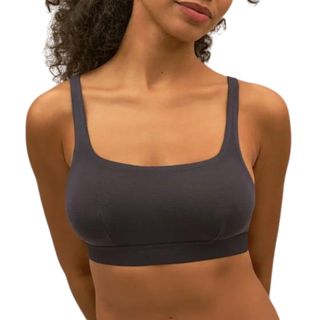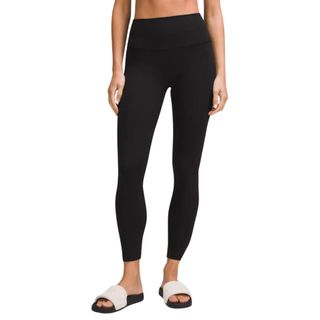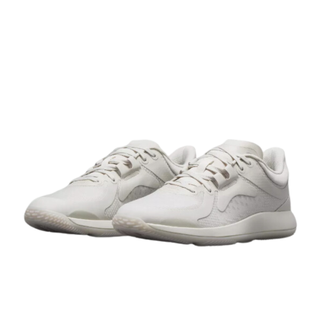You don't have to be a workout aficionado to name lunges as one of the best exercises. But have you ever wondered how effective lunges really are and if you should be prioritising them in the gym?
Look, we're all short on time and desperate for our workouts to work. So checking in that you're performing the most effective moves is a good step. And if your training sessions are littered with lunges, there's good news: studies show that lunges can improve muscle strength and balance in the legs.
"Lunges are highly effective for building muscle in the lower body," agrees Kate Sutton, a personal trainer and instructor at Sweat By BXR and Kobox. "They primarily target the quadriceps, glutes, hamstrings and calves, but also engage stabilising muscles in the core and hips."
However, the most effective lunge for you depends on so many variables. "Ultimately, the 'best' version depends on your individual strength, mobility, and any potential joint limitations," says Sutton.
Below, we'll explain the most effective way to lunge for results. And if you're looking for more lower-body education, then check out our features on bodyweight lunges, whether squats or lunges are more effective and the best leg exercises.
Ever wondered, how effective are lunges? Experts explain
What is a lunge?
Heard of the compound move but not 100% sure what it actually is? In short, a lunge is a lower body workout move which involves - yep, you guessed it - lunging forwards with either your left or right leg, bending your knee towards the floor, engaging your core, hamstrings, calves and glutes, and returning to standing.
Used in bodyweight strength training workouts but also weighted workouts, yoga, circuits and warm ups, they're a simple, functional movement that promise to strengthen both your leg and core muscles.
@selenaprins ♬ original sound - Bakhodur YusupovWhat are the benefits of doing lunges?
Lunges are brilliant at working many elements of fitness all at once.
Firstly, lunges help to build muscle and strength. "Lunges involve eccentric loading (making a muscle work in its lengthened position). Whether stepping forward, backward or to the side, they lead to significant strength gains and hypertrophy because of the increased tension placed on the muscle," says Sutton.
Lunges may also be more effective at building muscle in the glutes specifically than other types of lower-body exercise. In a small study, women performed weighted squats and lunges, 20 minutes apart. Researchers monitored muscle activation and found that both activated multiple muscles in the body, but lunges activated the glutes more. So, for those looking for stronger glutes (which most of us should, given they are the biggest muscles in our body), lunges are a great way to build muscle and strength.
"The unilateral nature of the exercise (working one leg at a time) requires more stability and balance, which also leads to better muscle recruitment," adds Sutton.
That brings us on nicely to the second best benefit of lunges: improving stability. As you'll be transferring weight into one foot and moving your lower body into a deep position while stabilising your upper body, your balance will be worked hard.
"Lunges engage stabilising muscles like the adductors and abductors (inner and outer thighs) and the core, helping improve balance and coordination. This makes them functional for everyday activities like walking and climbing stairs," says Sutton.
It works by improving stability in pretty much every lower-body joint, according to a 2022 report, including in the hip, knees, ankles and feet. In fact, traditional lunges were so good at improving balance that researchers found there was no additional benefit to building better balance when lunges were performed on an unstable surface.
"While lunges primarily work the lower body, they require significant core stabilisation to maintain posture and balance," adds Sutton. This engages the obliques and transverse abdominis, helping to strengthen the core muscles."
Another perk of the move is that it builds flexibility and mobility, as the stretch through the back leg on forward and reverse lunges, or the inner thigh in lateral lunges, keeps the muscles supple. "Lunges can also help improve hip flexibility by taking the joint through a full range of motion, which is particularly beneficial for people who spend long hours sitting at a desk," agrees Sutton.
Finally, one of the most underrated benefits of lunges is that they can be effective for injury prevention and rehabilitation. "Lunges help correct muscle imbalances between the left and right side, which can lead to better symmetry in the legs and reduce the risk of injury," says Sutton.
What is the most effective type of lunge?
There are many lunge variations you can do. As well as forward, reverse and lateral lunges, there are walking lunges and jumping lunges, and there are many ways to add weights and resistance to a lunge too.
Let's start with one of the most common types of lunge. "Reverse lunges in particular are great for those looking to avoid excess strain on the knees. When stepping backwards, the shin stays more vertical, reducing anterior knee stress," says Sutton. Research suggests reverse lunges may be better for people with knee sensitivity.
That does not mean they're the easiest: the glute max and certain areas of the quads also have higher muscle activation in reverse lunges compared to the other lunges, suggesting they're a safe and effective way to build muscle.
On the other hand, forward lunges have been shown to improve hamstring strength and sprint ability, making it a brilliant option for athletes who want to support their training.
"Starting with bodyweight lunges is a great option not just for muscle building but for coordination, proprioception and skill acquisition. You can intensify the bodyweight movement by slowing down the movement, then progress by adding dumbbells," suggests Sutton. "Holding the dumbbells at the side of the body will help in retaining balance in the movement. Hold a dumbbell at one side only to add an extra challenge to stability."
Using a barbell for lunges is good for those looking to load up significant amounts of weight and build more muscle. "Barbells will also challenge trunk stability and upper body stabilisation. You may need to rack and unrack the weight from a squat rack when the weight increases so much that you are unable to lift it safely from the ground to overhead."
@ericananglefit ♬ original sound - Erica NangleHow to do a lunge?
Good question - but do remember, there's a reason the move is so universally loved, and that's because it's both simple to do but also effective. Below, we explain how to do the most straightforward iteration of the move, the forward lunge.
- Start standing with both feet facing forward and placed directly under your hips. Remember to engage your core muscles.
- Stepping forward with one of your feet, making sure that it's in line with your toes. Lower your back knee to the floor, bending your knees so that your back shin is facing the floor and almost parallel with the floor. Meanwhile, your forward-facing leg should be at a 90-degree angle, with the knee facing forward and staying in line with the toe.
- Pause for a second, making sure to engage both your glutes and core muscles, before returning to your start position.
How To Do Lunges: Lunge Progression Exercises - YouTube

What's the most effective set and rep range for lunges?
Another way to make lunges more effective is to change how many you do - and how heavy you lift. "The best rep and set range depends on your goal," says Sutton.
For those wanting to build strength: "Perform three to four sets of six to eight reps per leg with heavier weights," she goes on.
For those wanting to grow more muscle: "Do three to four sets of eight to 12 reps per leg, with a moderate weight that allows for muscle fatigue by the last few reps," advises the expert.
For those wanting to improve muscle endurance: "Aim for two to three sets of a higher rep range (eg 12-20 per) leg with lighter weights or body weight is good."
Regardless of the rep range, ensure that you maintain good form, keeping your torso upright and core engaged to prevent injury.
Shop MC-approved gym kit for lunges now:

A more-secure-than-it-looks bra that is great for the gym yoga or brunch, this BAM design comes in a comfortable, soft fabric.

When you're lunging, placing your weight onto one foot with heavy weights in hand, you want to feel secure. And nothing makes me feel as secure as these super soft, high waist Align leggings.

Lululemon Strongfeel Training Shoes
These lululemon shoes are wide and flat to help me feel the floor and press through my feet effectively - but they're still super soft and comfortable. A great one for lunges, when you need to feel stable.




















 English (US) ·
English (US) ·